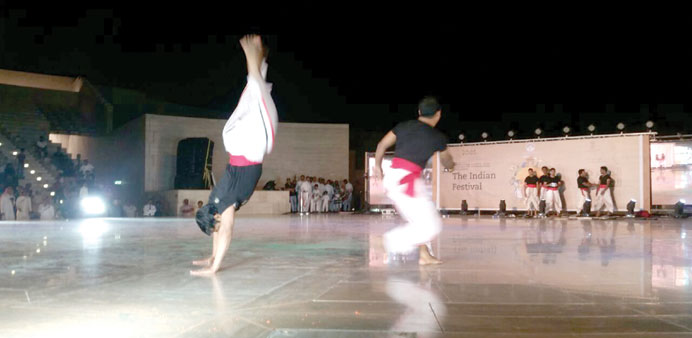DEFT MOVES: A display of Kalaripayattu, organised by QMASS, at the Indian Festival in Katara.
By Anand Holla
At massive community congregations such as A Passage to India, the two-day Indian Festival that won laurels last weekend, interesting facets of various organisations come to the fore.
One of the highlights of the festival was the action-packed display of Kalaripayattu, which is regarded as the mother of all martial arts, the oldest fighting system in existence and also the most scientific. With its high-energy moves, the South Indian martial art form that originated and thrived in the state of Kerala, makes for an amazing performance.
At the Katara amphitheatre, Qatar got its dose of Kalaripayattu, courtesy QMASS or Qatar Mahe Souhrida Sangamam – a forum of expatriates hailing from Mahe and the neighbouring regions in Kerala. The only Francophone Indian association affiliated to the Indian Cultural Centre (ICC) under the aegis of the Indian Embassy, QMASS has been involved in several reach-out programmes beneficial to the community here in Qatar and also back home.
Manmmadhan Mambally, President, QMASS, told Community, “ICC was particular about each of the affiliated organisations performing regional cultural items at the festival. So we decided to perform Kalaripayattu, in Kadathanadan style, which is our North Kerala’s own martial art form.”
The Kadathanadan Kalari Centre, located in the scenic Thekkady, is a major Kalari fight centre where this martial arts form is practised in a designed space and tourists come by to watch. “Young and old practice it in our place,” Mambally said, “In Mahe and Azhiyur, one can find Kalari training centres. This art attracts a lot of tourists to Mahe, where our regional administrator, Dinesh Mangalat, envisages a lot of touristic orientations and possibilities.”
Among practitioners of a variety of styles and lineages, the common elements in this martial system include preliminary techniques of exercise combined with seasonal full-body massage and daily application of medicinal oil to the entire body. The word ‘kalari’ refers specifically to the traditional roofed pits which served as a temple for worship, a gymnasium for martial exercise, and a clinic for treatments.
Mahe, which was once a French colony, lies between Kozhikode and Kannur districts. While the rest of Kerala was under the British rule till India got independence in 1947, Mahe remained a French colony for nearly two and half centuries, until it was integrated into the Union of India in 1954.
“The region is Francohone and most of us are either French-speaking or French-knowing,” Mambally explained, “Since the French ruled Mahe for more than 200 years, the relationship with the neighbouring regions were very strong and cordial, and we maintain it.”
In January, the organisation’s fourth term office-bearers were elected, and Mambally became the new President of QMASS, the secretary of which is Lilar Parambath and the treasurer is Shuaib Kunhikkandy. QMASS has been actively involved in organising socio-cultural activities in Qatar and Mahe, like their grand celebration of Kerala Piravi (the occasion marks the birth of the state of Kerala on November 1, 1956), last November.
“We are planing to celebrate Journee de la Francophonie soon, for which we expect support from French Embassy and Institut Francais. Another of our mega event in the pipeline is the Hariharan Musical Night,” Mambally said.

